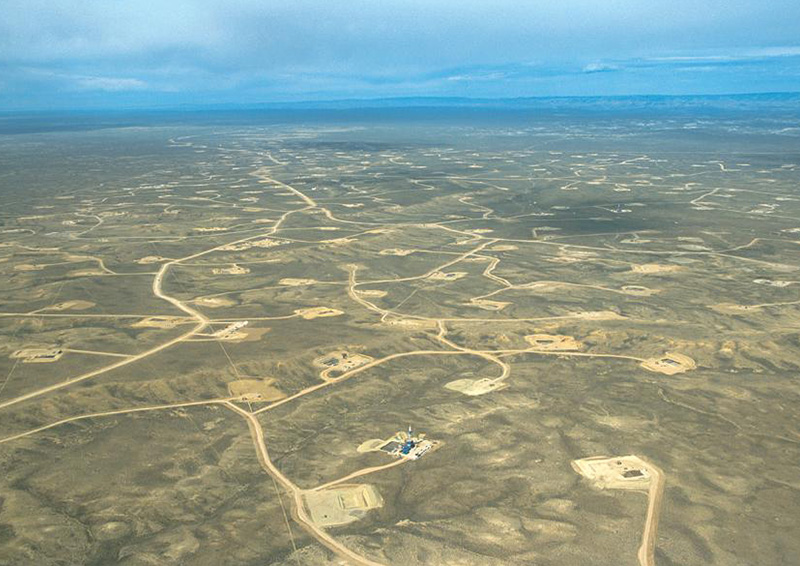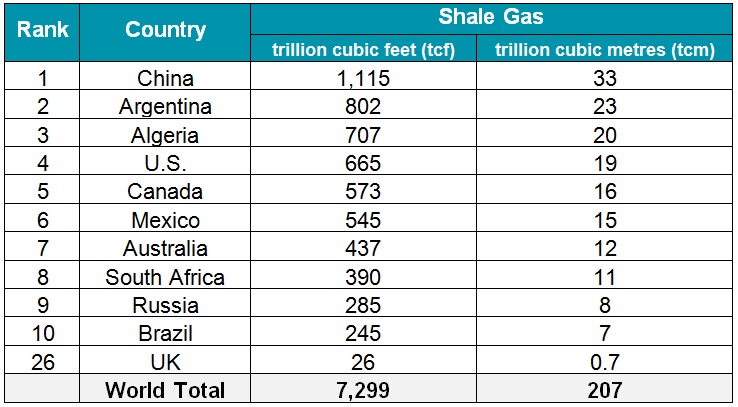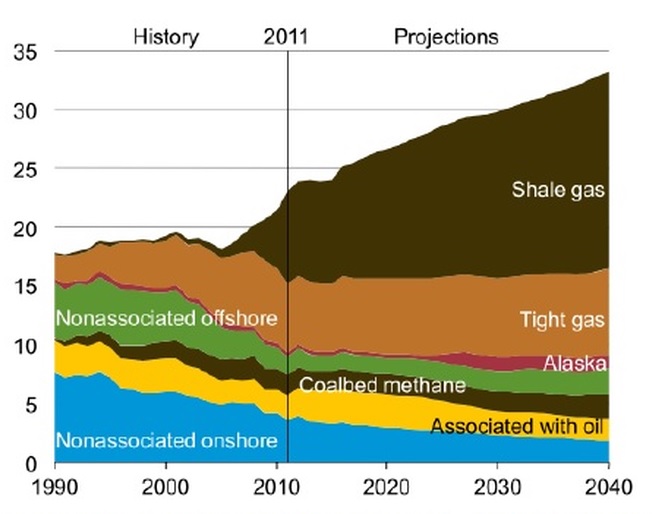Shale gas
Contents |
[edit] What is shale gas?
Shale gas refers to the natural gas (mostly methane) located in fractures and micro structure within shale rock. In the UK we have major shale rock formations across the south, Midlands, and north of England. The thickness of these deposits varies from tens of metres to thousands of metres. The British Geological Survey's study of the Bowland-Hodder shale estimated that the formation could be up to 4,000 m in thickness.
Many UK shale deposits contain both oil and gas hydrocarbon interstitial deposits. These hydrocarbons can be trapped within the source rock if it has a low permeability like shale. The trapped gas component, shale gas, is referred to as an unconventional gas reserve.
In the UK unconventional gas reserves may be present in sufficient quantities to make extraction commercially viable, subject to exploration and approval.
[edit] Development of shale gas in the UK
[edit] Current government policy
The UK Government is supportive of shale gas extraction subject to satisfactory regulatory planning and environmental control. The first policy document was published in October 2012 and updated in July 2013.
On 5 December 2012, the Secretary of State laid the Government's Gas Generation Strategy before Parliament. This included the Government's proposals for developing the UK's unconventional gas reserves. The strategy also included the establishment of an Office for Unconventional Gas and Oil (OUGO). OUGO aims to promote the safe, responsible, and environmentally sound recovery of the UK's unconventional reserves of gas and oil.
In December 2012, the Secretary of State for Energy and Climate Change announced that exploratory hydraulic fracturing for shale gas could resume in the UK. This followed the temporary moratorium that was imposed in 2011 following the 2.3 and 1.5 magnitude level seismic earthquakes that occurred after hydraulic fracturing in Lancaster.
In the March 2013 budget the Chancellor announced tax allowances for companies developing shale gas fields allowing them to offset their exploration spending against tax. As part of this announcement, the Government published a consultation paper in July 2013 on their shale gas tax proposals.
Currently in the UK, exploratory wells are being drilled to evaluate the practical and commercial potential of hydraulic fracturing for shale gas. These will provide more information for regulators, government and the public to determine the future course of shale gas extraction.
[edit] Regulation
The purpose of the UK's planning system is to achieve sustainable development. The National Planning Policy Framework (NPPF)(3) sets out the Government's requirements for the planning system and provides a framework and guidance for the preparation of local development plans. The NPPF states that the aim of local plans should be to make a positive contribution to the economic, social and environmental aspects of a region. With respect to the environmental aspects of sustainable development, local plans are expected to minimise pollution and other adverse effects on the local and natural environment.
Planning permissions are determined in accordance with the local plan. For all minerals developments (which includes on-shore oil and gas development) the planning authority needs to ensure that permitted operations for each phase of development (exploration, appraisal and production) do not have unacceptable adverse impacts on health, the natural environment or the historical environment.
Currently, a number of different bodies are involved in the planning and permitting regime for unconventional gas developments. These include the Department of Environment & Climate Change (DECC), the Environment Agency (for England), Natural Resources Wales, the Scottish Environment Protection Agency, the Health and Safety Executive and the Local Mineral Planning Authority. This list is not exclusive and other bodies may be involved.
Proposals for all oil and gas development, including shale gas, are subject to the requirements of the Town and Country Planning Act 1990 and are administered by the Minerals Planning Authority for the area in which development is located.
The Department for Communities and Local Government (DCLG) has published technical guidance which provides advice on the planning issues associated with each stage of gas development (exploration, appraisal and production).
The development of shale gas reserves is not currently classified as nationally significant infrastructure and as such these projects will not benefit from the Planning Act's streamline decision making.
DECC published a general guide on shale gas and hydraulic fracturing in 2014.
[edit] Licencing
Petroleum exploration, appraisal and development licences (PEDLs) enable a company to carry out exploration and extraction exclusively within an area. Licences bind the company to obey the licence conditions during the term of the licence. The licence periods are usually phased to accommodate the exploration, appraisal, development and production stages. The licence is separate from the other permissions that are required prior to carrying out any drilling activities. These include drilling and hydraulic fracturing consents, Health and Safety notifications, planning permissions, environmental permits and securing access rights from landowners.
The last round of onshore licensing (the 13th round) took place in 2008. DECC's oil and gas website provides details of onshore licences awarded during this round.
Following the completion of the Strategic Environmental Assessment and public consultation exercise, bidding for the 14th onshore licensing round opened in July and closed in October 2014. The 14th onshore round will enable new areas of exploration and facilitate the on-going assessment of the UK's shale gas resources.
[edit] Mineral rights and access
Under the Petroleum Act 1998, 'The Crown' retains almost all sub-surface rights to hydrocarbon reserves, including shale gas. An operator must obtain the access rights (ancillary rights) from the landowner in order to legally enter his land in order to exercise the rights granted by the licence. Such ancillary rights can be negotiated with the land owner or they can be compulsory purchased using Section 7 of the Petroleum Act 1998.
[edit] Global shale gas reserves
(Technically recoverable shale oil and shale gas resources: an assessment of 137 shale formations in 41 countries outside the United States June 2013 - source: US Energy Information Administration.)
The U.S. Energy Information Administration (USEIA) has updated its estimates of the technically recoverable shale gas resources in 41 countries. This are natural gas resources that could be produced with current technology. The figure is not dependent on the costs associated with above ground conditions, geology, drilling operations, gas volumes produced or market prices.
The 2013 USEIA report estimates that over 7,200 trillion cubic feet (tcf), equivalent to 206 trillion cubic metres (tcm), of shale gas is technically recoverable globally. This is higher than the current global estimates for natural gas at 6,839 tcf (194 tcm) and 58 times the annual global gas production of 124 tcf (3.5tcm).
[edit] US shale gas extraction
(US dry natural gas production by source, 1990-2040 (trillion cubic feet) - source: USEIA.)
US shale gas production has increased from 0.75 tcf (0.02 tcm) in 2005 to 8.1 tcf (0.2 tcm) in 2012. This could represent 50% of US gas consumption by 2040. The US's annual natural gas consumption in 2012 was 25.5 tcf (0.7 tcm) per annum.
According to the USEIA, proven US shale gas reserves were estimated at 97.4 tcf (2.8 tcm) and unproven shale gas reserves at 567 tcf (16 tcm).
Whilst these estimates seem impressive, the USEIA states that uncertainty remains about the size, economic viability and long term productivity of the resource. Further assessment and exploration will be required to improve the reserve estimates.
[edit] UK shale gas resource estimates
(The carboniferous Bowland shale gas study (tcf = trillion cubic feet, tcm = trillion cubic metres)
DECC published a British Geological Survey (BGS) study on the UK's unconventional hydrocarbon reserves in 2012. The study estimated that Britain's shale gas reserve potential was 5.3 trillion cubic feet (0.15 trillion cubic metres).
In 2013, DECC published a more detailed assessment carried out by the BGS study into shale gas reserves in the north of England. This report provided a central estimate of the 'gas in place' for the Bowland Shale formation at 1,329 tcf (37.6 tcm). However, the BGS has noted that the geology of the UK is more complex than the areas of the US that have been developed for shale gas. The values in the following table are theoretical and do not represent the recoverable quantities.
The recoverable gas resource is influenced by:
- Above ground conditions
- Geological constraints
- Technical recoverability
- Commercial viability
- Environmental constraints
Conventional oil and gas fields often quote a recovery rate of 10% of a field's total resource. Based on this, the Bowland Shale formation could provide 133 tcf (3.7 tcm) of recoverable shale gas. This is almost 50 times the UK's annual domestic and industrial gas consumption of 2.8 tcf (0.08 tcm).
[edit] The role of gas in the UK's energy system
Gas currently satisfies a large share of the UK's energy needs. It provided 41% of the UK's electricity generation in 2011 and 82% of its domestic heating fuel. In recent decades, the UK has had access to major supplies of North Sea gas, but production has halved since 2000. In 2011, gas imports exceeded production for the first time since large scale extraction began in the North Sea. Piped gas from mainland Europe and Liquefied Natural Gas (LNG) from the Middle East are being used increasingly to meet demand.
Over the long term, shale gas production could contribute to our gas supply mix by displacing imported gas. This would increase our security of supply. However, at this stage in its development there is insufficient information to indicate how significant shale gas production will be.
Over the next 10-15 years, the importance of gas in electricity generation is likely to increase. This is due to decommissioning of many coal and nuclear power stations, delays to proposed nuclear builds, and growth of share of intermittent renewable generation. Gas generation is a flexible technology. It is able to provide steady base load (the amount of power needed to meet normal customer demands) and be flexible to meet peak demands and/or to replace fluctuating renewable energy generation.
It must be recognised that gas combustion is a significant source of carbon dioxide, the principal greenhouse gas. To meet our 2050 carbon reduction targets, large scale deployment of low carbon generation will be required. The Government predicts a need for 40-70 MW of new capacity by 2030.
[edit] How is shale gas extracted?
Shale has a low permeability and the natural gas trapped within it cannot easily flow into an extraction well. Vertical and horizontal drilling with hydraulic fracturing is used to increase the permeability of the shale surrounding the well. This facilitates the flow of gas from within the shale rock into the extraction well. The radius of extraction of a single well is limited to the extent of the horizontal drilling, which is usually between 1-3 km.
Therefore, extraction on a commercial scale requires a large number of wells. Some estimates put the potential extraction capacity of a single well at 1 billion cubic feet (bcf). This implies that for 'technically recoverable' reserves of between 5.3 tcf (0.15 tcm) and 133 tcf (3.76 tcm) (10% of the BGS 'gas in place' estimate) between 5,000 and 130,000 wells would be required. This number of wells would raise significant issues for consenting, water use, logistics and land-use planning in the UK. In the US there are approximately 500,000 wells for the extraction of unconventional (90%) and conventional (10%) gas.
The processes of well construction and gas extraction involve a number of stages:
Firstly, an extraction well is drilled. To support the hole during drilling and to aid removal of drill cuttings, an oil-based or polymer-based fluid is circulated down the well hole. Once drilled, a steel casing is installed down the well hole and cement grouted into place. This seals the well to prevent cross migration between the well hole and overlying geology. The well casing extends below any water-bearing strata, aquifers or permeable rock layers.
Once the casing has been installed, the drilling continues vertically and then horizontally into the shale formation.
The fracturing fluid is mixed at the surface (water, sand and chemical additives) and pumped into the well hole at high pressure. The horizontal part of the well hole is sealed off in sequential sections (stages) and fracturing fluid pumped under pressure to create a network of fractures in the shale rock. The fracturing fluid contains sand which 'props' open the fractures and prevents them from closing up.
Hydraulic fracturing fluid contains 90% water, 8-9% sand and 1-2% additives. Hydraulic fracturing additives typically contain hydrochloric acid, sodium chloride, ethylene glycol, salts, potassium carbonate, hydroxyethyl cellulose and isopropanol. Composition of the hydraulic fracturing fluid may vary from site to site depending on the geology present.
After completion of the fracturing process, depressurisation and the weight of the overlying rock (overburden pressure) squeezes waste water and natural gas back into the well hole to the surface where they are collected. This waste water contains fracturing fluid (water, sand and additives), drilling fluids (oil-based or polymer-based) ground water, low levels of naturally occurring radioactive minerals (NORM), dissolved salts, metals, organic chemicals and inorganic chemicals from the shale rock.
[edit] Key environmental risks
Environmental risks are present at each of the key stages of development:
- Drilling
- Completion & hydraulic fracturing
- Production
- Gas treatment and transportation
This section will focus on the key environmental risks during well construction (drilling, completion and hydraulic fracturing).
[edit] Construction and operations
The normal environmental risks are present during site construction and operations. These include noise, dust and air pollution as well as soil and surface water contamination from construction equipment oil and diesel products. During well construction, site activities also include the storage and use of a wide range of chemical products, compounds, flow back waste water and drill cuttings.
[edit] Groundwater and aquifer contamination
Drilling a well can create a migration path between ground water and aquifers and the underlying shale rock. The hydraulic fracturing of a large mass of shale rock can cause gas or dissolved minerals to migrate through the shale or along the well casing into neighbouring rock strata, aquifers and ground water.
The risks are small providing the well bores and casings are properly sealed and the shale formation is located at a significant depth below the aquifer level. The management of risk associated with hydraulic fracturing is regulated using the Environmental Permitting Regulations 2010 and the Water Framework Directive.
[edit] Seismic activity
Seismicity can be induced or triggered when stress or pressure changes promote slips along fault lines. Hydraulic fracturing under high pressure using large volumes of fluid injection directly into or adjacent to fault lines can increase the potential for movement. The large amount of faulting in UK strata increases the susceptibility for ground movement and opening up of new pathways for fluid movement. However, a good understanding of UK geology, monitoring and regulation will minimise this risk.
[edit] Water usage
Well construction and hydraulic fracturing needs a large quantity of water. Depending on the depth of the shale formation, each well hole may require up to 1,000 m3 of water and each lateral bore 10,000 m3 of water to drill. Oil-based or polymer-based fluids are also used during well hole drilling. Drilling and fracturing water is normally delivered to each well pad using road tankers. For each 10,000 m of water delivered or removed from site, 330 articulated tanker journeys (each 30 m3) are required. Traffic emissions, road congestion and accident risk increase as a result.
After hydraulic fracturing is complete, as much as 3,000 m3 of waste water flows back to the surface from the well as it is depressurised. Flow back water contains fracturing fluid (water, sand and additives), drilling fluid, ground water, dissolved methane, bubbles methane, very low levels of naturally occurring radioactive minerals (NORM), dissolved salts, metals, organic chemicals and inorganic chemicals from within the shale rock.
The fluid used for hydraulic fracturing typically has around 0.5-1% additives content. Therefore, for each lateral bore requiring 10,000 m3 of water, 50-100 m3 of additives will be required, some of which are toxic.
Wastewater collected at the surface would be an 'extractive waste' and its disposal would be regulated under the Mining Waste Directive and Water Framework Directive. Water companies will have a role to play with regard to water supply and waste water treatment.
[edit] Air pollution
Air pollution can result from vehicle movements, site preparation, combustion fuels, vented emissions flaring and fugitive emissions. These can affect human health and the environment.
The top soil strip, construction traffic movements and the construction of each well pad can cause airborne dust. Environmental impacts from airborne dust can be significantly reduced by using normal dust suppression techniques.
Fugitive emissions can include methane and other natural gases released while preparing the well ready for production. Methane is the main element of natural gas and it is also a greenhouse gas. Fugitive emissions can be significantly reduced by using conventional mobile plant to separate volatiles and hydrocarbon condensates from flow back water and gas production.
The Environment Agency has produced a report to provide information on the monitoring and control of fugitive methane emissions from onshore unconventional gas operations.
A recent study by DECC concluded that "if adequately regulated, local greenhouse gas emissions from shale gas operations should represent only a small proportion of the total carbon footprint of shale gas, which is likely to be dominated by CO2 emissions associated with its combustion."
The DECC study also concluded that "the carbon footprint (emissions intensity) of shale gas extraction and use……makes shale gas's overall carbon footprint comparable to gas extracted from conventional sources."
[edit] Condensates
In the U.S. about half of the shale gas wells provide hydrocarbon condensates as a by-product of shale gas extraction (propane, butane and pentane). Condensates are hydrocarbons that liquefy at room temperature or under pressure. The Environment Agency believes that UK shale gas wells will produce high quality gas that will not contain condensates (16). If exploratory studies show that condensates will be present, conventional mobile plant can be used to separate the solid, liquid and gas phases associated with flow back water and gas production.
[edit] Drill cuttings
The drilling of the well bore results in the production of well cuttings. These contain drill fluids, naturally occurring chemicals, naturally occurring metals and naturally occurring radioactive materials (NORM). NORM levels can vary between rock types. Low, medium or high NORM concentrations would require an environmental permit and disposal at a landfill in accordance with the Environmental Permitting Regulations (England and Wales) 2010.
[edit] Other issues
[edit] Associated infrastructure
In the US well pads are connected to each other via a network of connecting pipelines. In the UK we are at the exploration stage and it is not yet known if production well pads would be interconnected or stand alone.
[edit] Production rates
In general a shale gas well produces gas at a lower rate and lower pressure than a conventional gas well. Published production rates over time for US shale gas wells show that gas production drops by 80-95% over the first five years of production. The production rates over time for UK shale gas deposits are not currently known. However, new wells will need to be regularly drilled at each well pad in order to maintain viable production levels.
This article was originally published as 'Shale Gas' at ICE on 9 Jan 2014. It was written by Ben McAliden.
--The Institution of Civil Engineers
NB: In May 2018, the government announced a consultation about whether the early stages of shale exploration (fracking) should be treated as permitted development, and the circumstances in which this might be appropriate. (Ref. https://www.gov.uk/government/news/new-measures-to-back-british-shale-gas-exploration)
[edit] Related articles on Designing Buildings Wiki
- Articles by ICE on Designing Buildings Wiki.
- Biogas.
- Carbon capture and storage.
- Electricity supply.
- Energy storage.
- Fossil fuel.
- Hydroelectricity.
- Liquefied petroleum gas (LPG).
- Mains gas.
- Marine energy and hydropower.
- Microgeneration.
- Natural gas.
- Oil - a global perspective.
- Peak oil.
- Renewable energy.
- The future of electricity in domestic buildings.
- Types of fuel.
[edit] References
- Department of Energy & Climate Change (July 2013). The Carboniferous Bowland Shale gas study: geology and resource estimation.
- Department of Energy & Climate Change (July 2013). Providing regulation and licensing of energy industries and infrastructure (14 October 2014).
- Department for Communities and Local Government (March 2012). National Planning Policy Framework.
- Department for Communities and Local Government (July 2013). Planning practice guidance for onshore oil and gas.
- Department of Energy & Climate Change (July 2013). About shale gas and hydraulic fracturing (fracking).
- Department of Energy & Climate Change. URL: www.gov.uk/oil-and-gas-petroleum-licensing-guidance#applying-for-a-licence (5 November 2013).
- U.S. Energy Information Administration (July 2013). Technically Recoverable Shale Oil and Shale Gas Resources: An Assessment of 137 Shale Formations in 41 Countries Outside the United States.
- U.S. Energy Information Administration (April 2013). Annual Energy Outlook 2013 Early Release.
- U.S. Energy Information Administration. (2012). Natural Gas Statistics. URL: www.eia.gov/energyexplained/index.cfm?page=natural_gas_home#tab2 (14 October 2013).
- Department for Communities and Local Government (2012). The Unconventional Hydrocarbon Resources of Britain's Onshore Basins - Shale Gas.
- Department of Energy & Climate Change (2013). Gas Energy Trends. URL: www.gov.uk/government/publications/gas-section-4-energy-trends (14 October 2013).
- Department of Energy & Climate Change (2011). The Carbon Plan: Delivering our low carbon future.
- FracFocus (2013). What chemicals are used? URL: fracfocus.org/chemical-use/what-chemicals-are-used (14 October 213).
- Environment Agency (August 2012). Evidence. Monitoring and control of fugitive methane from unconventional gas operations.
- Department of Energy & Climate Change (2013). Potential Greenhouse Gas Emissions Associated with Shale Gas Extraction and Use.
- House of Commons, Energy and Climate Change Committee (May 2011). Shale Gas. Fifth Report of Session 2010-12 Volume 1
Featured articles and news
Delivering for tenants; National Retrofit Hub
New report offers recommendations to strengthen energy efficiency standards to protect private renters.
Government consultations for the summer of 2025
A year of Labour, past and present consultations on the environment, the built environment, training and tax.
CMA competitiveness probe of major housing developers
100 million affordable housing contributions committed with further consultation published.
Homes England supports Greencore Homes
42 new build affordable sustainable homes in Oxfordshire.
Zero carbon social housing: unlocking brownfield potential
Seven ZEDpod strategies for brownfield housing success.
CIOB report; a blueprint for SDGs and the built environment
Pairing the Sustainable Development Goals with projects.
Types, tests, standards and fires relating to external cladding
Brief descriptions with an extensive list of fires for review.
Latest Build UK Building Safety Regime explainer published
Key elements in one short, now updated document.
UKGBC launch the UK Climate Resilience Roadmap
First guidance of its kind on direct climate impacts for the built environment and how it can adapt.
CLC Health, Safety and Wellbeing Strategy 2025
Launched by the Minister for Industry to look at fatalities on site, improving mental health and other issues.
One of the most impressive Victorian architects. Book review.
Common Assessment Standard now with building safety
New CAS update now includes mandatory building safety questions.
RTPI leader to become new CIOB Chief Executive Officer
Dr Victoria Hills MRTPI, FICE to take over after Caroline Gumble’s departure.
Social and affordable housing, a long term plan for delivery
The “Delivering a Decade of Renewal for Social and Affordable Housing” strategy sets out future path.
A change to adoptive architecture
Effects of global weather warming on architectural detailing, material choice and human interaction.
The proposed publicly owned and backed subsidiary of Homes England, to facilitate new homes.
How big is the problem and what can we do to mitigate the effects?
Overheating guidance and tools for building designers
A number of cool guides to help with the heat.
The UK's Modern Industrial Strategy: A 10 year plan
Previous consultation criticism, current key elements and general support with some persisting reservations.
Building Safety Regulator reforms
New roles, new staff and a new fast track service pave the way for a single construction regulator.






























